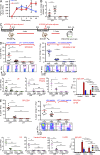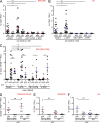Classical Flt3L-dependent dendritic cells control immunity to protein vaccine
- PMID: 25135299
- PMCID: PMC4144735
- DOI: 10.1084/jem.20131397
Classical Flt3L-dependent dendritic cells control immunity to protein vaccine
Abstract
DCs are critical for initiating immunity. The current paradigm in vaccine biology is that DCs migrating from peripheral tissue and classical lymphoid-resident DCs (cDCs) cooperate in the draining LNs to initiate priming and proliferation of T cells. Here, we observe subcutaneous immunity is Fms-like tyrosine kinase 3 ligand (Flt3L) dependent. Flt3L is rapidly secreted after immunization; Flt3 deletion reduces T cell responses by 50%. Flt3L enhances global T cell and humoral immunity as well as both the numbers and antigen capture capacity of migratory DCs (migDCs) and LN-resident cDCs. Surprisingly, however, we find immunity is controlled by cDCs and actively tempered in vivo by migDCs. Deletion of Langerin(+) DC or blockade of DC migration improves immunity. Consistent with an immune-regulatory role, transcriptomic analyses reveals different skin migDC subsets in both mouse and human cluster together, and share immune-suppressing gene expression and regulatory pathways. These data reveal that protective immunity to protein vaccines is controlled by Flt3L-dependent, LN-resident cDCs.
© 2014 Anandasabapathy et al.
Figures







Comment in
-
Dendritic cells: The true face of migratory DCs.Nat Rev Immunol. 2014 Oct;14(10):649. doi: 10.1038/nri3741. Epub 2014 Sep 5. Nat Rev Immunol. 2014. PMID: 25190284 No abstract available.
References
-
- Bedoui, S., Prato S., Mintern J., Gebhardt T., Zhan Y., Lew A.M., Heath W.R., Villadangos J.A., and Segura E.. 2009a. Characterization of an immediate splenic precursor of CD8+ dendritic cells capable of inducing antiviral T cell responses. J. Immunol. 182:4200–4207 10.4049/jimmunol.0802286 - DOI - PubMed
Publication types
MeSH terms
Substances
Grants and funding
- KL2 TR000151/TR/NCATS NIH HHS/United States
- R01 AI040045/AI/NIAID NIH HHS/United States
- AI40045/AI/NIAID NIH HHS/United States
- K23 AR063461/AR/NIAMS NIH HHS/United States
- N01 AI040045/AI/NIAID NIH HHS/United States
- 13013/PHS HHS/United States
- AR063461-01A1/AR/NIAMS NIH HHS/United States
- P01 AI081677/AI/NIAID NIH HHS/United States
- FS/13/49/30421/BHF_/British Heart Foundation/United Kingdom
- RR024142/RR/NCRR NIH HHS/United States
- R01 AI013013/AI/NIAID NIH HHS/United States
- 81677/PHS HHS/United States
- KL2 RR024142/RR/NCRR NIH HHS/United States
LinkOut - more resources
Full Text Sources
Other Literature Sources
Medical
Molecular Biology Databases
Miscellaneous

